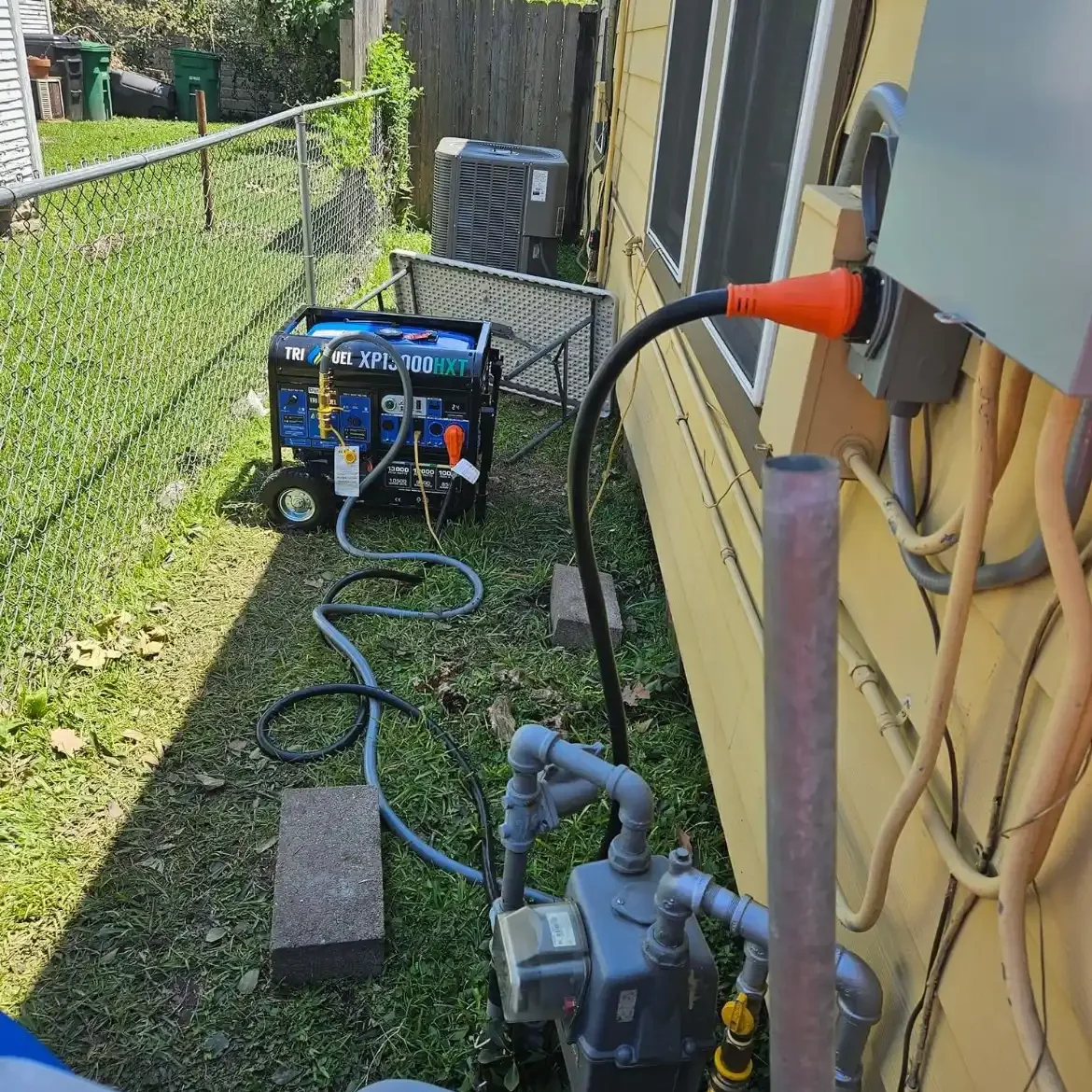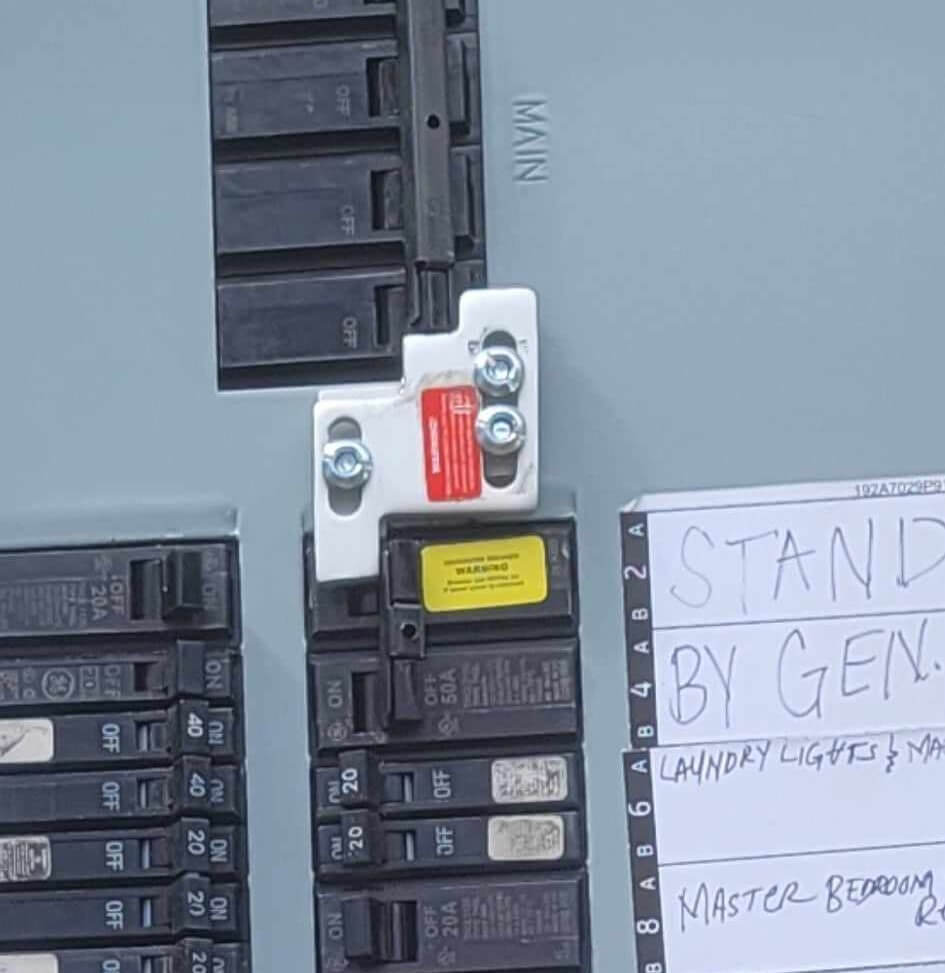Have you dealt with multiple power outages in your home? Maybe it’s time for a portable generator for hurricane outages. Here’s a quick look at our shopping process for a portable generator for a 1500 square foot 3 bedroom/2 bath ranch style home in Near Northwest Houston. Hopefully this will help you pick the right generator for your home as well.
Always work with a licensed and insured electrician and plumber when installing your portable generator. Also check local regulations in your area regarding permitting requirements.
Table of Contents
- What’s the Proper Size Generator for my Home?
- What Kind of Portable Generator Do I Need?
- How to Install a Portable Generator to Power Your Home
- Portable Generator Connected to a Home: See An Example
- How Long Can a Portable Generator Continuously Run?
- How Often Do I Need to Change the Oil in my Portable Generator?
- How to Avoid Carbon Monoxide Poisoning with a Portable Generator
- So What Did We Buy?
What’s the Proper Size Generator for my Home?
You want the most powerful portable generator for your home, right? Wrong. You want the right size portable generator for your home. These things are expensive. You don’t want to under or over buy for your needs.
When you are sizing a portable generator for your home, your best bet is to talk to an electrician first. They can quickly assess your maximum starting power and running power needs for your home. But, you can also calculate it yourself.
First let’s understand those 2 terms:
- Starting Power Watts (or Peak Watts) – the amount of power needed to start an appliance
- Running Power Watts – the amount of power needed continuously to keep an appliance running.
For example, your refrigerator may need 1200 watts of power when the motor cycles on, but then only uses 200 watts when it’s running.
We found this generator size estimator from Consumer Reports quite useful as a starting point in our investigation.

Then we found this generator size calculator from Primal Survivor.

Using this tool we calculated we need 7,000 starting watts and at least 4,000 running watts for our 1500 square foot home, including running the 2-ton central HVAC.
If you want to get specific with the electric devices in your home instead of using an online tool, grab a piece of paper and fold it to create 3 columns. Label column 1 Appliances, column 2 Starting Power and column 3 Running Power. Next, make a list of what appliances you must have during a power outage, along with those that are nice to have and luxuries. Then take a look at the wattage label on your devices to find their wattage. Need help finding the wattage? Use this article on What Appliances Use the Most Electricity or use our energy usage calculator.
Running a generator at full load can shorten its lifespan, so it’s worth overestimating your power requirements rather than planning to draw maximum power continuously.
Primal Survivor
Given our research, and keeping the above in mind, we decided to look for a generator with 10,000 starting watts.
What Kind of Portable Generator Do I Need?
Once you’ve calculated how big a generator you need, you need to evaluate the type of generator and noise levels.
Tri Fuel vs. Dual Fuel Generators
A dual fuel generator can run on gasoline or propane. A tri fuel generator can run on gasoline, propane or natural gas.
If you can afford it, a tri fuel generator gives you the ultimate flexibility, without having to continue purchasing gasoline or propane during a hurricane. With a natural gas connection, you’ll have access to unlimited fuel for your generator.
Make sure you read the fine print on your selected generator before you “add to cart.” A generator will have different starting watts depending on the fuel source. For example, the generator we were considering has 10,000 starting watts with gasoline, but only 7,500 starting watts when using natural gas.
Inverter Generator vs. Generator
How loud is a portable generator? In simple terms, very. But if you’re inside, it’s only your neighbors that have to deal with it. 😄 Seriously though, it’s a big consideration. Check the decibel level rating on the generator you purchase.
An inverter generator is typically quieter than a traditional generator. You can find out more about generators vs. invertor generators in this article we found.
How to Install a Portable Generator to Power Your Home
Electricity can kill you. Carbon monoxide can kill you. Do not try to wire your portable generator to your home yourself. Do not hire your mother’s brother’s friend’s cousin, even if it seems like the cheapest route. Hire a licensed and insured electrician. Plus hire a licensed and insured plumber if you go with tri gas.
To power your house with a portable generator you will need a 30/50 amp power inlet box on your breaker box, an interlock kit and a 30/50 amp power cord. For tri-fuel generators, you will also need a quick connect fitting added to your gas meter.
Here’s a checklist of what you need to install a portable generator to power your home:
- 30/50 amp power inlet box – installed on your home as a connector to your main power system
- 30/50 amp power cord – the heavy duty cord that will connect your portable generator the the power inlet box
- Interlock Kit – a crucial piece that your electrician will install in the breaker box, the interlock kit isolates your main breaker from your generator’s back feed. This is crucial to avoid the risk of fire, damage to local transformers or possible loss of life for those working on the local power lines.
- Quick Connect Fitting – your plumber will install a quick connect fitting on your gas meter to connect your gas line
- Gas Regulator – your gas line will have a gas regulator device on it for pressure regulation.
- Portable Generator Enclosure – portable generators are not made to withstand the elements. They should not be out in the pouring rain. You will need to build a portable generator enclosure, or look online for a generator running cover for under $200. Don’t just put it in the garden shed out back and shut the door, or you will risk a dangerous concentration of carbon monoxide.
Do I need 30 amp or 50 amp connections? Your electrician can best advise you on the type of power inlet you need for your home. This is determined by the size of generator you purchase. “30 amp can only offer 7,200 watts at best through one outlet whereas 50 amp can theoretically offer 12,000 watts through one outlet” according to Generator Decision.
If you plan to run your central HVAC system on a portable generator, you may also need a soft start for your compressor.
- Compressor Soft Start– This device reduces the in-rush current for your HVAC unit so it gradually increases the power draw. This can cut your starting power by 60-75%, reducing the size requirement for your generator.
You can calculate the starting wattage for your HVAC by looking at the label on the side of your unit. Look for volts and LRA (locked rotor amps). For my HVAC system is was 208-230 volts and an LRA of 79, meaning I need 18,170 starting watts (230*79). Running on natural gas, there’s no portable generator that comes close to that.
But with a soft start installed, the starting wattage will drop to around 5,500 watts, totally doable with a portable generator.
Portable Generator Connected to a Home: See An Example
Here’s a generator set-up in the Houston Heights area.
You’ll notice the 50 amp connector (orange plug) in the first image. In the second image you can see the quick connect fitting. And in the third image you can see the Interlock kit that isolates generator power from the main switch. This is a professionally installed portable generator.
The only concern we had with this setup is it’s too close to the house. We talked to the homeowner about this.
During Hurricane Beryl, they directed the exhaust away from the house and had multiple carbon monoxide detectors, none of which showed any presence of CO in their home.
Their long-term plan is to build a generator shed and direct the exhaust up and above the roofline, due to their small lot size.



How Long Can a Portable Generator Continuously Run?
How long you can run your portable generator is based on both the size (wattage) and load (usage) of your system.
For example, a natural gas powered generator could run up to 500 hours without stopping, or 21 days (source: GeneratorMag). A gasoline powered generator may need to stop every 12-18 hours for refueling.
Read your owner’s manual regarding how long your generator can run continuously. That’s not only a safety recommendation but also a warranty recommendation.
How Often Do I Need to Change the Oil in my Portable Generator?
Most new generators have a burn-in time of 8-12 hours before their first oil change. After the burn-in period you may have to change the oil every 50-100 hours. Your generator should have a run-hours meter on it. If not, log the running hours on your calendar or in your phone. Read your owner’s manual regarding both oil changes and filter changes.
How to Avoid Carbon Monoxide Poisoning with a Portable Generator
Your portable generator emits carbon monoxide as a by-product, in its exhaust.
Carbon monoxide is colorless, odorless and tasteless. And it can kill you.
Make sure your portable generator has proper ventilation and is situated at least 10 feet from your home. Purchase several carbon monoxide alarms and place them around your home when running your portable generator.
If a carbon monoxide alarm goes off, exit the building immediately and call the fire department. Do not re-enter the building until they give you the all clear.
So What Did We Buy?
Based on this evaluation (plus multiple online discussions with neighbors and a Facebook group) I went with a Westinghouse Tri Fuel 12000W tri fuel portable generator. I also have a MicroAir Easy Start 368 on back-order, since my 10-year old HVAC system is a beast on starting wattage, and the Easy Start will cut that wattage by 60-75%.
Now I just need it hooked up. Anyone know a licensed electrician and plumber in Houston?
NOTE: We do electricity plans, not generators. When installing your portable generator, work with a licensed electrician and plumber. Check with local authorities regarding permits and regulations for connecting generators to gas lines if you plan to run on natural gas.
